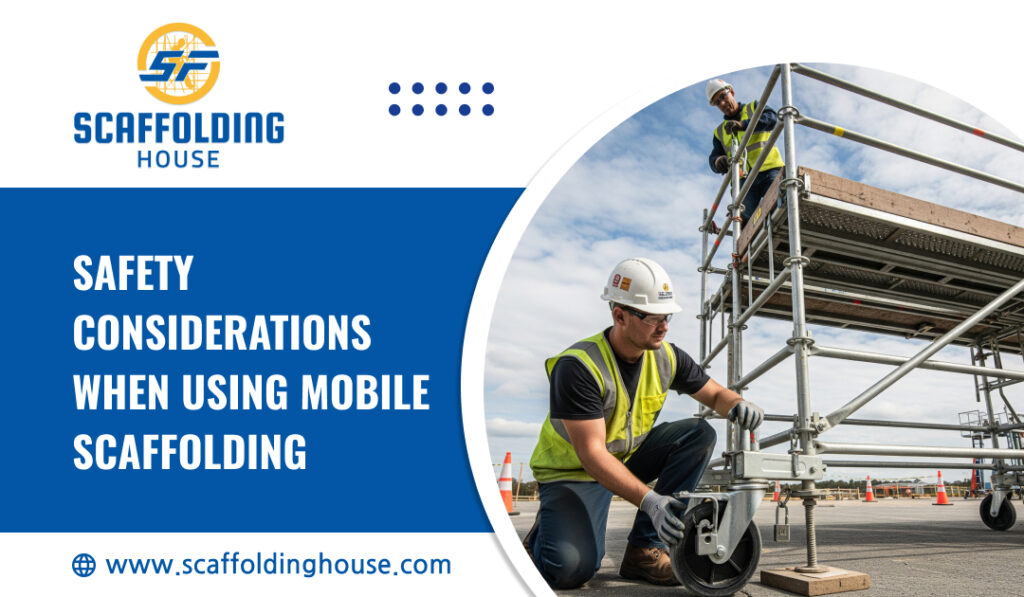Mobile scaffolds have become a crucial tool in maintenance, construction, and home improvement projects because of their portability, lightweight construction, and long-lasting durability. Unlike traditional scaffolding, these systems are easy to move and provide flexibility, allowing workers to access elevated areas and locations on the job site with ease. This blog post will explore the effectiveness of mobile scaffolding, its benefits, and important safety tips to ensure your next project runs smoothly and safely.
Benefits of Mobile Scaffolding
- Lightweight Yet Sturdy: When it comes to aluminium scaffolding systems, they are lighter, making it easier to transport around the work site without sacrificing strength. It’s durable enough to support significant weight, ensuring stability for a wide range of tasks.
- Enhanced Mobility: Mobile tower scaffolding comes with wheels, allowing for quick and easy movement between work areas, reducing downtime and increasing productivity. This is especially useful for tasks that require frequent repositioning, such as painting or window washing.
- Corrosion Resistance: Aluminium naturally resists rust and corrosion, making it ideal for both indoor and outdoor use. This resistance helps extend the life of the scaffolding, particularly in harsh weather conditions or humid environments.
- Simple Assembly and Disassembly: Most mobile aluminium scaffolds are designed for quick setup, without the need for specialized tools or heavy labor. This feature is particularly advantageous for temporary tasks or projects that require frequent assembly and disassembly.
Safety Guidelines for Using Mobile Scaffolding
- Inspect Before Use: Always check for visible damage, loose bolts, or bent frames before using the scaffold. Ensuring that all parts are secure will reduce the risk of accidents and improve stability.
- Lock the Wheels: Before climbing, make sure to engage the scaffold’s wheel locks to prevent any movement. Most mobile scaffolds are equipped with brakes that should be fully activated during use.
- Mind the Weight Limit: Every scaffold has a specified weight capacity, including the worker’s weight and any tools or materials.
- Avoid Overreaching: Position the scaffold as close to the work area as possible to avoid reaching or leaning too far.
- Use Guardrails and Safety Gear: Guardrails are crucial for preventing falls, especially on higher platforms.
Mobile Scaffold Erection Procedure
- Start by inserting the castors into the base frames and locking them in place. If the scaffold is intended to be stationary, consider using adjustable bases instead. As a trusted aluminium scaffolding supplier in Dubai, we ensure to provide you with the best quality adjustable bases.
- Attach at least one horizontal brace to the frame, ensuring it is positioned above the first rung with the snap hook facing downward.
- Add another horizontal brace to the opposite end of the first brace, securing it to the two horizontal braces that have already been set up.
- Install a brace diagonally across the opposite uprights just below the first rung.
- Verify that the base of the scaffold is square by checking all corners.
- Level the base both vertically and horizontally using a spirit level. Adjust the castors accordingly to ensure proper alignment.
- To enhance stability, install two diagonal braces on the base frames.
- Position the next end frames on top of each base frame, making sure to place diagonal braces both above and below where the frames connect.
- Install a platform about 1 meter off the ground, ensuring it sits between the two end frames.
- Set up the ladder access platform 1 meter above the temporary platform, providing the first working platform to reduce fall risks. While doing this, make sure the opening section of the ladder is properly fitted.
- Install guardrails around the working platform for worker safety. Select the appropriate type of guardrails based on the mobile scaffold’s design.
- Remove the temporary platform and place it adjacent to the working platform. Now the working platform will include both the ladder access and the access ladder platform.
- If the working height will exceed a certain limit, install outriggers.
- Use the internal ladder to access the first working platform.
- Repeat the previous steps, ensuring to install ladders and working platforms at 2-meter intervals.
- Finally, install toeboards at each working deck level. Ensure the scaffold is properly constructed and remains vertically aligned.
Conclusion
Mobile scaffolding offers portability, durability, and flexibility, making it ideal for various tasks. Ensure you purchase scaffolds from a reputable manufacturer, such as Scaffolding House.

